|
Flemish Legion Awards The Flemish produced numerous military and political awards for their pro-nazi party Dinaso and later referred as the "Vlaamsch Nationaal Verbond" (Flemish National Front). The most prestigious awards were those named after party leaders, the so-called van Severen and Tollenaere Badges. | |
|
The Commemorative Joris van Severen Loyalty Badge 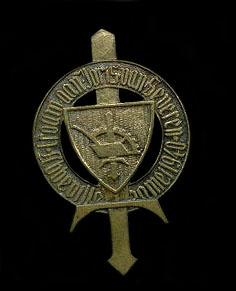
The commemorative Joris van Severen loyalty badge, properly referred as the "Dinasokenteken" Dinaso Badge was instituted after the murder of the Flemish Verdinaso leader on May 20 1940 in Abbeville, France. The recipients of the award were those political men who were arrested by the Belgium government prior to the German invasion of May 1940. There were two classes made, a silver type for Officers and a bronze for lower ranks. The van Severen bronze badge shown on the left is a die cast. The front side is formed from a large medallion, with a shield in its center and sword pointing upwards crossing horizontally. The emblem in the center of the shield shows a sword, which represents the Flemish will to fight trough its history, the plough stands for their traditional agriculture, and the cog wheel for the technology. On the medallion it has the inscription "Trouw aan Joris van Severen - Abbeville - 20 Mei 1940 " (Loyalty to Joris van Severen -Abbeville -May 1940). The reverse is solid with two small loop rings that holds the pin. Also it should be noted that there exist van Severen badges, which have a slight design variations with the lettering, color and size. Another variation of the van Severen badge exist it is slightly smaller in size. This badge is pictured in David Littlejohn's book, Vol 4, in the addendum section, page 280." | |
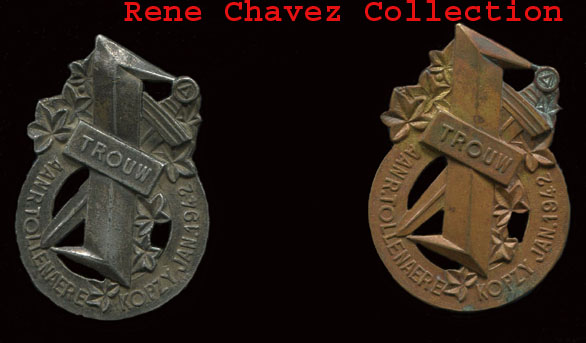
The Tollenaere Commemorative Honor badge The Tollenaere commemorative honor badge correctly known as the "Tollenaere Kenteken" also referred to as the "Trouw" or the "Kopzy" badge was the second most prestigious award. The badge was probably created during summer of 1942 and most likely authorized by V.N.V. leader Staf De Clercq. The first awards were issued to uniform V.N.V. members on July 12, 1942 during a ceremonial meeting held in Brussels. | |
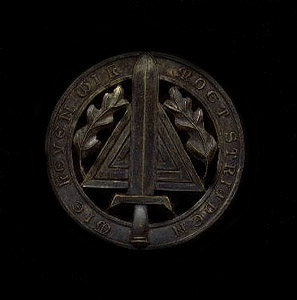
The Flemish Anti-Terrorist Award The Flemish Anti-Terrorist Award shown is a very rare decoration awarded to those who had been subjected to attack by Terrorist (Resistance). This badge was instituted in 1943 in three classes bronze, silver and gold. The Badge shows a medallion with the motto "Wie Leven Wil Moet Strijden" (Who Would Live, Must Fight). The Triangle within the circle represents the VNV Emblem. A sword is shown in the center, which represents the Struggle against Bolshevism. The hollow reverse shows the impression of the obverse and has two eyelets one at the top and the other at the bottom of the badge. The badge measures 42mm in diameter and is slightly concave. | |
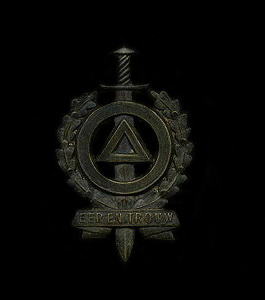
The Flemish VNV War Merit Award The Flemish VNV War Merit Award shown on your right is another extremely rare decoration instituted in June 1944. This award is known as the "Eer en Trouw" (Honor and Loyalty) Badge. It was awarded in bronze only for special acts of courage at home or at the Eastern Front. The badge was also awarded for those killed in action or by terrorist. It was die stamped with the two loop style hinge, and mounted on a commemorate plaque. | |
|
Flemish made insignia 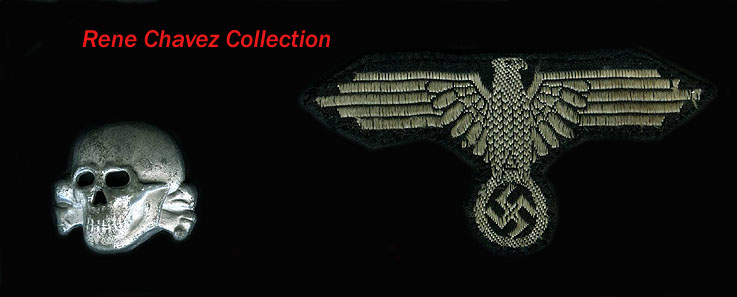
Above are Flemish made Waffen-SS insignia. Collectors mistakenly referred them as Reitz made insignia, however, there is no conclusive evidence that they were made by that manufacturer. The "Totenkopf" headgear insignia has also been used on Dutch SS headgear. The reverse shows two thin rounded pins similar to the "Assmann" type skulls. Certain sources indicate that this badge was made by the "Indian Caps" Belgium firm in Antwerp. | |
|
Flemish Langemarck document 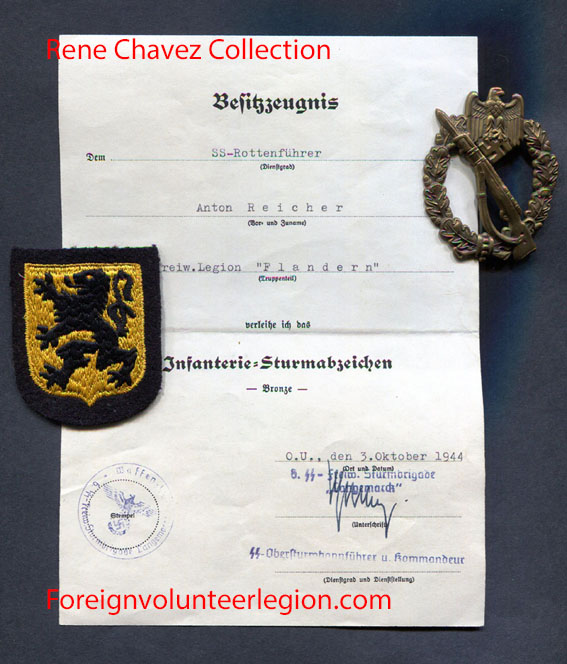
Flemish SS Sturmbrigade Langemarck Infantry Assault badge in bronze awarded to Flemish Legion volunteer. Document has been signed by SS Legion Commander Conrad Schellong. | |
|
Walloon Legion Awards | |
|
Rexist Badge of Honor 10 may 1940 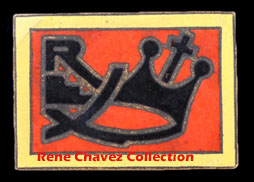
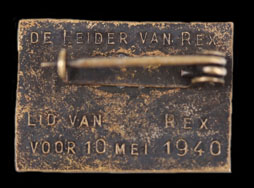
Rexist badge
of honor of 10 may 1940 was awarded to members of Rex Party who were arrested and imprisoned
at the time of the German invasion in May 1940 There exits two types: Flemish made
and Walloon made. | |
|
The Wallonien BeVo Cufftitle
The cuffband was authorized to be worn on SS uniforms. It is not known when the cuffband was
issued but based on the few photos of the cuffband being worn it would appear that it was after its
upgrading to divisional status. I believe the cuffband was probably issued Spring of 1944 after the
heavy engagement of the SS-Sturmbrigade Wallonien in the battle of the Korsun-Cherkassy.
The remnants of the sturmbrigade return to Belgium where parades were held in Brussels and
Charleroi. 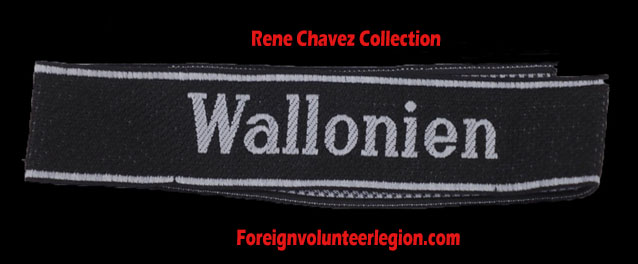
The Walloon Honor Rexist Badge | |
|
The Walloon Honor Rexist Badge The Walloon
Honor Rexist Badge shown above known as the "Blood Order" was created during the Spring of 1941 and was awarded to members of the "Formations de Combat" of the Rexist Militia. Unofficially Wallonie volunteers wore the badge before being transferred to the Waffen-SS. In October 16, 1944, RFSS H. Himmler authorized the award to be worn on German SS uniform. Above are two Wallonie Rexist Honor badges a bronze and a silver class. The basic design for the bronze and silver was the same. Both badges have the Walloon Bergundy Cross with a sword crossing it surrounded by a circular ring with the French inscription reads "Bravoure Honneur Fidelite" (Bravery, Honor and Loyalty).
Notice that both badges have a hollow back with a hinge and a broad "C" style catch with a Belgium style pin. The difference is that the bronze badge has serial no. 1558 on the lower bottom right corner of the circle while the silver badge does not have a serial number.
With kind permission of John J. Hoynoski I am posting new information relating to the Wallonie Rex
badges. 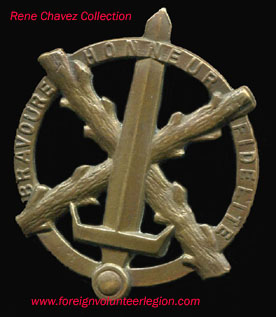
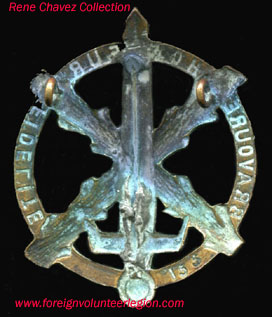
Interestingly the early issue bronze badges did not have the pin assembly instead it had in the reverse three loops soldered directly to the metal. These loops were secured in the uniform by thread. The badges do not have makers mark but all have serial numbers and were issued to all para-military members of "Formation de Combat — F.C." of the Rexist Militia. 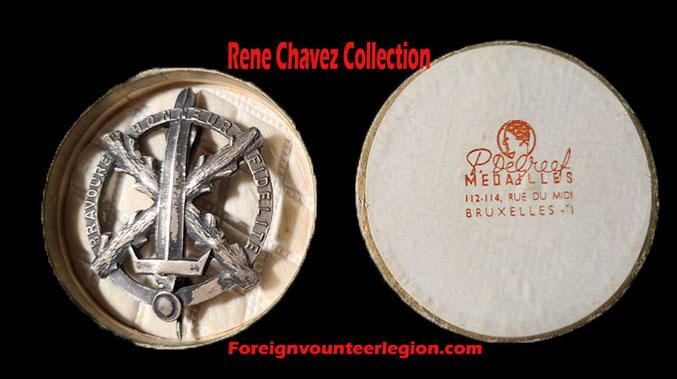
Shown is a very rare Walloon Silver Rex Honor badge with circular case. The circular carboard case has the firms address printed in the center "P. De Greef, Rue du Midi, 112 Brussels." This indicates that the firm was located in Brussels, Belgium. Only two circular cases have been found. 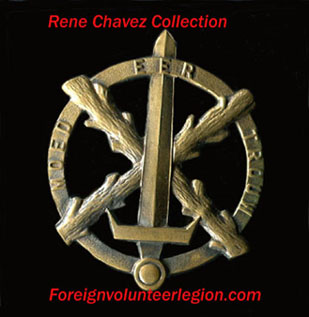

This badge was issued to Flemings that had settled in the French speaking part of Belgium and represented the VNV in Wallonia. This badge has been rumored to be made by the Belgium firm "Fisch & Foncon." 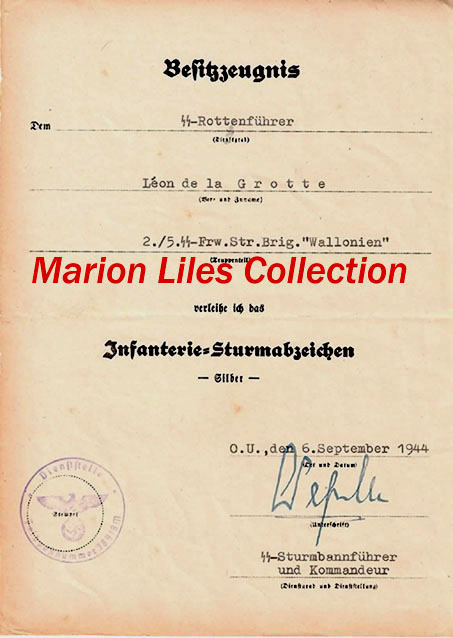
Very rare silver infantry assault badge document given to a SS Wallonie volunteer in early September 1944. This document has been signed by DeGrelle (from the collection of Marion Liles). |